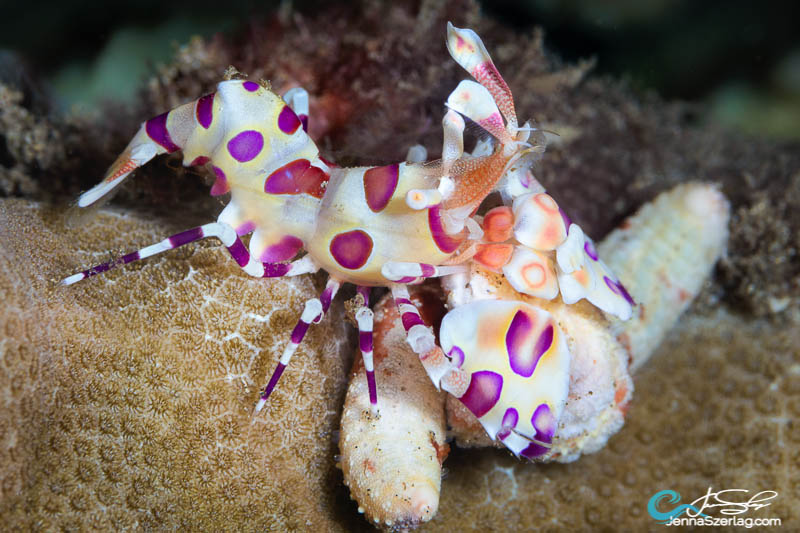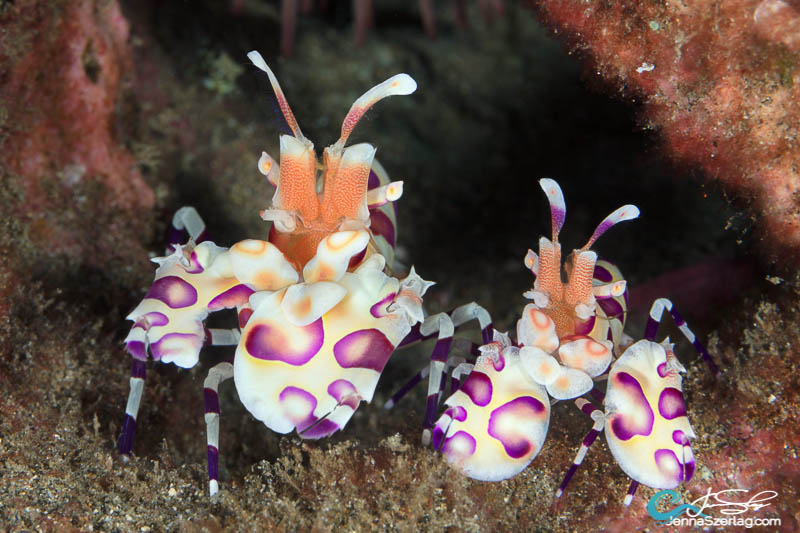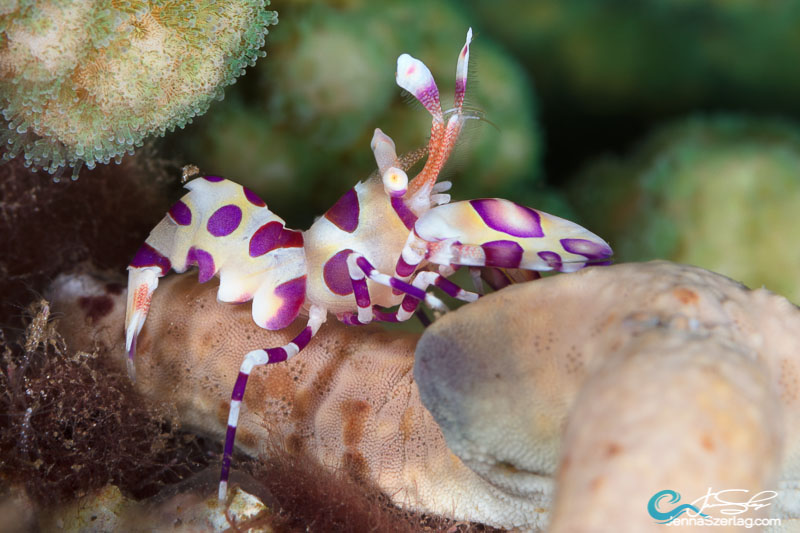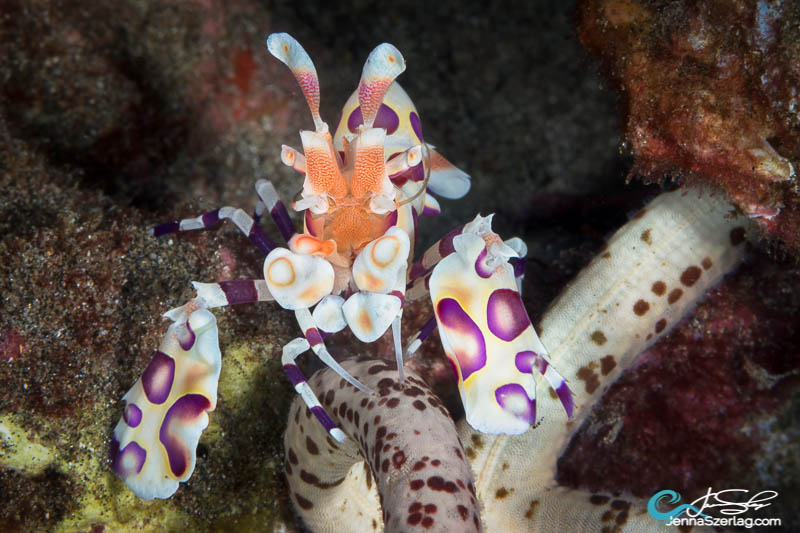Harlequin Shrimp
Remember the scene in the original Karate Kid movie where the old sensei instructs his young protégé in the finer points of car polishing…. “wax on, wax off!”? Watching a pair of Harlequin Shrimp waving their flat, paddle-like claws in slow, concentric circles, I can’t get that scene out of my mind. These gentle-looking, inch-long crustaceans are hardly as agile as even a beginning Karate student, yet are fierce predators nonetheless.
Found throughout the tropical Indo-Pacific and Hawaiian Islands, they feed exclusively on sea stars, attacking and eventually subduing animals that may be 100 times their own weight and size. Even the huge Crown-of-Thorns, which have almost no natural enemies, are not safe around these guys.
JUMP TO:
Photography Tips for Harlequin Shrimp
Where to find Harlequin Shrimp
Best Lenses

If you’ve ever tried to lift a large sea star from a rocky substrate, you know about their strong grip… it takes considerable effort even for a human. It’s hard to imagine how these little shrimp could prevail over such forces, but they take it in stride. Working as a team, one shrimp methodically snips suction-tube feet from each arm of its prey. Meanwhile, its partner grabs an arm-tip and backs up like a tractor, gradually pulling the sea star over onto its back. Once that’s accomplished, the pair drag their hapless victim off to a preferred dining spot, typically under a rocky ledge or coral head.
Subduing such large prey must be a real challenge, but eating it all in one sitting would be a physical impossibility. However, nothing goes to waste, as the shrimp devour the sea star one arm at a time, keeping the increasingly disfigured animal as a live captive until every bit is eaten. Depending on the size of the sea star, this process may take up to two weeks… pretty horrific, huh? Maybe Karate Kid isn’t the best movie reference for these remorseless killers after all; Hannibal Lecter in Silence of the Lambs suddenly seems more appropriate!

Facts About Harlequin Shrimp
It's no wonder why the Harlequin shrimp is so sought after as an underwater photography subject. With their glamorous colors and attractive appearance they fill an image with bright pleasing color. Not to mention they almost pose proudly for photographers with their starfish meals. Here are a few facts about our beloved shrimp:
Behavior: Usually found in pairs and territorial. Females are larger than males. They often stay in one location for months.
Diet: Harlequin shrimp are verocious eaters. They feast on most species of starfish found within their habitat that at most times can be much larger than themselves. A starfish meal may last up to two weeks.
Range: Hymenocera Elegans are found in Indo-Pacific and Hymenocera Picta in Hawaii. The two look similar except the color variations. In Hawaii, they have large reddish purple spots often with yellow surrounding them. Indo-Pacific harlequin shrimp have spots that tend to be browner with a blue outline.
Concerns: Aquarium collection for trade. Do not disclose exact locations of any harlequin shrimp online.
It's important as a photographer to respect underwater marine life, and not to harass these shrimp just to get the perfect shot. I've heard stories of dive guides keeping them in a bag, and putting them out when it's time for a diver to get a shot. This is terrible and behavior like this should be actively discouraged by all divers. The best thing to do, is to enjoy whatever marine life you find underwater, and not to pressure dive guides to find any one particular species.
Photography Tips for Harlequin Shrimp
Harlequin Shrimp can be difficult to photograph with their reflective white bodies. It is easy to blow out the details in bright highlights if you are not careful with your strobes. Try to expose for their brightest part, which will usually be in their claws if facing directly at you. Sometimes an angle from the side, a profile view, can help to subdue hotspots on its body gleaming back at the camera.
Harlequin shrimp are not skittish and tend to stand their ground to divers. Most often, one will find them slicing up a starfish and enjoying their lunch perfectly posing for the camera. Capturing animal behavior in you shot is always a great way to create visual interest.
Try to aim your focus on the eye. If you are able to select your focal point on your camera, move it to where the eye will be in the frame then compose your shot with the focal point directly over the closest eye. Good bouyancy is key here, their eyes are tiny!
Harlequin shrimp have beautiful colors. Think about the kind of background you want to make these colors pop.Does the background has contrasting colors? Both a background with sharp focus or a nicely blurred background make great underwater photographs. A good understanding of how aperture controls your depth of field and how different strobe positions control how much is illuminated is helpful. Your background will change dramatically just by changing your angle by a few inches. The difference will make completely different photos!
- Be conservative with your exposure as to not create hot spots on the shrimps reflective body
- Focus on the eye
- Capture its behavior - eating the starfish!
- Pick a background that compliments its colors to make the shrimp stand out

Best Lens Options for Harlequin Shrimp
60mm Lens: On a cropped sensor camera the 60mm is good for photographing shrimp in their habitats.Auto-focus is fast, night photography is easy, and you can get close to the subject. Also good for low-visibility dives.
100mm / 105mm Lens: This lens is great for filling the frame and blurring out the background and for those hard to reach crevices that shrimp like to reside in due to the increased working distance.
Fisheye Lens: These lenses could give you a creative image with expansive backgrounds. Possibly include the entire coral head it is living under? You will need to get very, very close so that the shrimp doesn't look non existant in the frame. Check the focal distance of your lens before diving with it to learn its limitations for shrimp photography.
Compact Cameras: If you zoom out you will get the effect of a 60mm lens. If you're looking for the effect of a longer lens such as the 100mm, zoom in all the way. Wet lenses will give you additional macro capability.
Further reading on lens selection - Macro lenses for underwater photography, Lens basics for beginners, 60mm vs 100mm macro lenses

Dive Destinations for Harlequin Shrimp
Harlequin Shrimp are found in the Indo-Pacific range and the islands of Hawaii. Most photos of Harlequin Shrimp that you see have been taken specifically in Lembeh, Seraya Bali, and Maui. They can be very difficult to find and sightings are not guaranteed but it is common that once the shrimp is spotted it will be seen at one location for several months.
- Lembeh Strait, Indonesia
- Hawaii
- Anilao
- Cebu
- Puerto Galera
- Mabul
- Walindi Papua New Guinea
- Ambon
- Andaman Sea Thailand
- Pacific Coast of Costa Rica
- Kumami Japan



Further Reading
Underwater Critter List for Macro photographers
Best Muck Diving locations
RECOMMENDED ARTICLES
SUPPORT THE UNDERWATER PHOTOGRAPHY GUIDE:
The Best Service & Prices on u/w Photo Gear
 Visit Bluewater Photo & Video for all your underwater photography and video gear. Click, or call the team at (310) 633-5052 for expert advice!
Visit Bluewater Photo & Video for all your underwater photography and video gear. Click, or call the team at (310) 633-5052 for expert advice!
The Best Pricing, Service & Expert Advice to Book your Dive Trips
 Bluewater Travel is your full-service scuba travel agency. Let our expert advisers plan and book your next dive vacation. Run by divers, for divers.
Bluewater Travel is your full-service scuba travel agency. Let our expert advisers plan and book your next dive vacation. Run by divers, for divers.
































